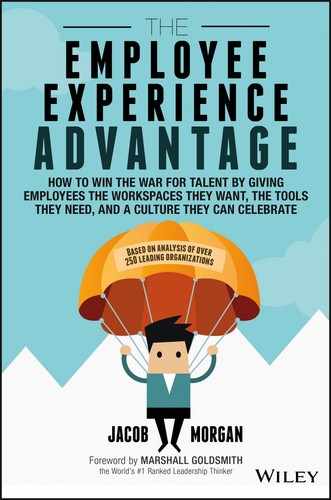CHAPTER 12
Business Metrics and Financial Performance
Comparing the nine categories on these lists clearly reveals some interesting insights. However, I wanted to take this one step further and look at some financial data and business performance metrics. I looked at data provided by organizations such as Yahoo! Finance, PayScale, and Fortune. Although I couldn't find every metric for every company, I was certainly able to cover the vast majority of them. I compared Experiential Organizations with other categories based on employee turnover, median pay, revenue per employee, and profit per employee. Figure 12.1 looks at Experiential Organizations versus nonExperiential, and Figure 12.2 provides a breakdown of how Experiential Organizations perform versus all the other categories of organizations.

Figure 12.1 Business Metrics for Experiential Organizations

Figure 12.2 Business Metric Comparison by Organizational Category
Experiential Organizations had 20 percent fewer employees, 40 percent lower turnover, 1.5× the employee growth, 2.1× the average revenue, 4.4× the average profit, 2.9× more revenue per employee, and 4.3× more profit per employees when compared with nonExperiential Organizations. I'd recommend you reread that last sentence a few times and let those numbers sink in. Looking at these numbers also makes it quite clear that Experiential Organizations are also the most productive. This should convince even the most skeptical reader or executive that investing in employee experience does have a significant financial impact on the organization. Another interesting thing to note is that, perhaps not coincidentally, Experiential Organizations also pay their employees 1.6× more than the nonExperiential Organizations.
Let's say we had two organizations, ACME A (representing Experiential Organizations) and ACME B (representing nonExperiential Organizations). Applying the numbers from the opening of this chapter, Table 12.1 shows how that would translate for two fictitious organizations.
Table 12.1 ACME A and ACME B Business Metrics
| Company | Employees | Revenue | Turnover | Revenue per Employee | Profit | Profit per Employee | Pay per Employee |
| ACME A | 70,000 | $10.5 billion | 4,000 | $150,000 | $4 million | $88,000 | $95,000 |
| ACME B | 100,000 | $5 billion | 6,700 | $50,000 | $900,000 | $20,000 | $63,000 |
Of course these are completely made‐up numbers, but it's easy to see how the impact here can be in the billions of dollars.
To drive this point across even further, I also compared stock price performance of the various categories of organizations and included the Standard & Poor's (S&P) 500, NASDAQ, Glassdoor's Best Places to Work 2016 list (for large companies), and Fortune's 100 Best Companies to Work For in 2016 (from Great Place to Work). To do this I looked at the stock price of all the included organizations, from January 2012 through October 2016, and assumed a starting investment of $1,000 for all the categories of organizations. I looked at this in two ways. In Figure 12.3 you can see that I grouped some categories together based on how many of the employee experience environments they were investing in (culture, technology, and physical space). This means that all the Emergent organizations were grouped together, and the Engaged, Empowered, and Enabled organizations were grouped together. In Figure 12.4 everything is broken down individually.

Figure 12.3 Category Stock Price Performance with $1,000 Investment

Figure 12.4 All Company Stock Price Comparison with $1,000 Investment
Some of the Experiential Organizations were also part of Glassdoor's and Fortune's lists, but regardless, the Experiential Organizations outperformed everyone by a considerable margin. Looking purely at stock price performance, the results aren't exactly what you would expect. Although Experiential Organizations outperformed everyone else, there were some surprises. For example, Technologically Emergent Organizations performed better than most other organizations as did the Enabled Organizations (scoring higher than the preExperiential group). Still, we can't simply rely on stock performance alone to justify the investment in employee experience, which is why I also looked at all the other elements above. But, it's reassuring to see that Experiential Organizations outperformed everyone else, even when it comes to financial investment. Although other organizations do see business value from investing in even some areas of employee experience, it's quite apparent that there's a bit of a winner‐take‐all outcome here. The organizations that truly see considerable business value and impact are the ones that excel at all three employee experience environments. They are amazing when it comes to culture, technology, and physical space, and as a result they become amazing companies.
Looking at all of this, it's apparent that Experiential Organizations have higher customer satisfaction scores and rankings; have top‐notch innovation practices; are the most attractive and respected places to work; are the most valuable brands; are also smarter, greener, happier, and more diverse; have the best people teams; and have the best camaraderie when compared with any other category of organizations. They are also more likely to deliver higher returns on performance benchmarks when compared with their competition, and they provide a higher return on investment when looking at stock price performance. Surely, this should be enough to convince even the most skeptical of readers, business leaders, and executives that investing in employee experience should be a top priority.
Figure 12.5 will help you conceptualize the employee experience business outcomes that the Experiential Organizations realize. It also puts into context how the concepts in this book fit together. Starting at the very left we have the Reason for Being, which guides how the organization invests in COOL spaces (Chapter 5), ACE technology (Chapter 6), and a CELEBRATED culture (Chapter 7). These are the elements that shape the employee experience, which in turn drives employee engagement. As a result of having a highly engaged workforce, the organization sees tremendous business value. Still, it's not just any organization that sees this business value. It's the one that does an amazing job of investing in employee experience.

Figure 12.5 Employee Experience Business Outcomes
